When you are planning an indoor farm, some of the first decisions you’ll need to make are how many square feet of canopy you will need and how big do you want your individual rooms to be. Your architect needs that information before they can do… well, anything. And so will everyone else on the design team.
There are a variety of factors that influence the answers to those questions—from budget to lighting load to cultivation style to overarching market goals—we couldn’t begin to list them all here. But one of the most crucial elements to consider when sizing your facility is how your room and overall facility sizes will affect your HVAC system costs.
Obviously, HVAC systems will increase in total upfront cost the larger your facility is. You might expect to see the cost of your HVAC to have a linear relationship, and to look something like the graph below.
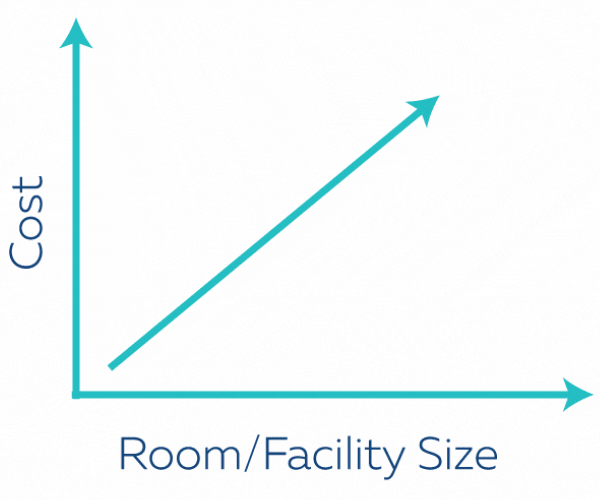
But did you know that as facilities increase in size, the increase in cost (regardless of technology) isn’t necessarily linear, and that some design decisions will allow you to get more HVAC tons per dollar than others? Check out the graphics below to help you get an idea of how the cost per ton of common HVAC approaches may change with room and overall facility square footage.
Note that this information should serve only as a data point, as there are a number of compelling reasons that any of these technologies could be the right choice for your facility. For example, this article does not take operational costs into consideration. For in-depth load calculations and equipment sizing, contact us today. We’ll discuss your goals and what each option brings to the table to help you meet them.
VRF/VRV Systems
In Variable Refrigerant Flow (VRF) and Variable Refrigerant Volume (VRV) systems:
- Tend to have fairly linear costs per ton
There is little impact to the cost per ton of output with changes in either room or facility square footage. This is because the overall size of VRF system outdoor condensing units is limited, usually to something in the 5-30 ton range. Also, fan coils and air handlers are usually limited to a maximum of 10 tons with these types of systems.
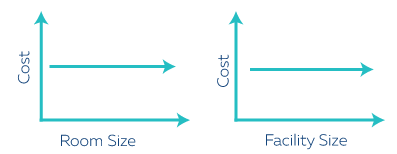
Even though the condensing unit can be shared between rooms or with a number of fan coils, the number of fan coils or air handlers to which they can be connected is also limited, usually to a ratio of 1.3-1.5 fan coil tons for each condenser ton (depending on the manufacturer).
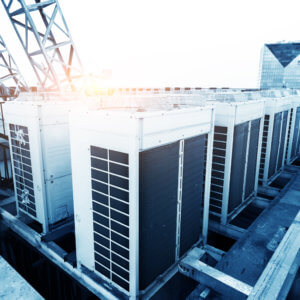
This means that, once you’ve exceeded the maximum number of tons of cooling that you can get from a single unit, you have no choice but to add units, which tends to add fairly linear cost to the overall system. There is some variation in cost in relation to condensing equipment size but it usually evens out with the various size units on a project and small rooms or projects can use single phase VRF or mini-split air conditioners.
Integrated Packaged DX Units
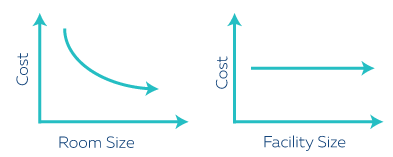
The rule of thumb for integrated packaged DX units with hot gas reheat for cultivation applications is:
- Room size increases will result in cost per ton decreases per room
- Overall size of the facility will make little difference in price per ton of output for the entire facility
While the price per Integrated Packaged DX unit may go down with larger rooms, the number of units required will correlate directly to the number of rooms in the building.
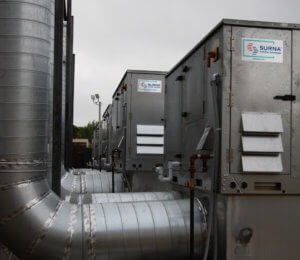
This is because the size of the individual units can increase to accommodate the size of the rooms they’re serving, resulting in a lower price per ton for each unit. Smaller units are more expensive per ton because integrated DX units have a lot of parts (like multiple coils, valves, sensors, and controls) which are all required no matter the size of the unit.
However, it doesn’t matter how large the facility is, or how many rooms there are in the facility, because unless you want to share air between rooms, each unit can serve only one room, and each unit (or units, when designing with redundancy) should be adequately sized for the room in which it serves.
Put simply, while the price per unit may go down with larger rooms, but the number of units required will correlate directly to the number of rooms in the building.
Chilled Water Systems (2 Pipe and 4 Pipe)

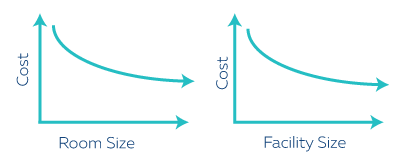
Chilled water systems let you share a central plant without sharing air between rooms, which allows for several chillers to serve an unlimited number of rooms.
- Cost per ton decreases slightly as the room size increases
- Cost per ton decreases significantly as the facility size increases, especially with 4-pipe
With 2-pipe chilled water, we find that as room size increases, you may see slight decreases in cost per ton on a room-by-room basis. But the real cost per ton savings come when the facility itself increases in size.
As chillers grow in size, the cost per ton will typically decrease by a significant margin, which is the main contributor to the decrease in cost per ton in larger facilities. In addition, some of the highest quality chillers are only available in larger sizes.
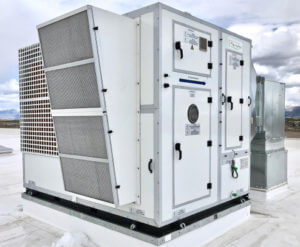
While both systems decrease in cost per ton as the facility size increases, the decrease in cost per ton in relation to room size is more significant with 4-pipe chilled water. Although air handling costs per ton can decrease with the larger room sizes in both instances, larger air handlers (often custom) are more common for 4-pipe chilled water to achieve lower leaving air temperatures for dehumidification. These air handlers decrease in cost per ton with size. The controller on an air handler or for each room will also be a somewhat fixed cost per room and so can be spread over more grow space in larger rooms.
2-pipe systems use standalone dehumidifiers that scale linearly in cost as you add more, and often use multiple smaller fan coils per room instead of larger air handlers.
Understand Your Options
Keep in mind that these are generalities meant as a high-level overview of the relationship between grow room HVAC sizing and costs. There are exceptions to every rule, so if you’re ready to discuss the pros and cons of each approach for your unique facility, or if you’re ready for a firm budget for the various options available, contact us today for a free consultation.

